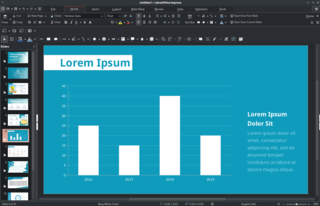Related Research Articles

Silicon Graphics, Inc. was an American high-performance computing manufacturer, producing computer hardware and software. Founded in Mountain View, California, in November 1981 by James Clark, its initial market was 3D graphics computer workstations, but its products, strategies and market positions developed significantly over time.

A microcomputer is a small, relatively inexpensive computer having a central processing unit (CPU) made out of a microprocessor. The computer also includes memory and input/output (I/O) circuitry together mounted on a printed circuit board (PCB). Microcomputers became popular in the 1970s and 1980s with the advent of increasingly powerful microprocessors. The predecessors to these computers, mainframes and minicomputers, were comparatively much larger and more expensive. Many microcomputers are also personal computers. An early use of the term "personal computer" in 1962 predates microprocessor-based designs. (See "Personal Computer: Computers at Companies" reference below). A "microcomputer" used as an embedded control system may have no human-readable input and output devices. "Personal computer" may be used generically or may denote an IBM PC compatible machine.

Li-Chen Wang is an American computer engineer, best known for his Palo Alto Tiny BASIC for Intel 8080-based microcomputers. He was a member of the Homebrew Computer Club and made significant contributions to the software for early microcomputer systems from Tandy Corporation and Cromemco. He made early use of the word copyleft, in Palo Alto Tiny BASIC's distribution notice "@COPYLEFT ALL WRONGS RESERVED" in June 1976.

The Homebrew Computer Club was an early computer hobbyist group in Menlo Park, California, which met from March 1975 to December 1986. The club had an influential role in the development of the microcomputer revolution and the rise of that aspect of the Silicon Valley information technology industrial complex.

In computing, a presentation program is a software package used to display information in the form of a slide show. It has three major functions:

WAOW is a television station in Wausau, Wisconsin, United States, affiliated with ABC and owned by Allen Media Group. The station's studios are located on Grand Avenue/US 51 in Wausau, and its transmitter is located on Rib Mountain.
WKOW is a television station in Madison, Wisconsin, United States, affiliated with ABC and owned by Allen Media Group. The station's studios are located on Tokay Boulevard on Madison's west side, and its transmitter is located on South Pleasant View Road in the city's Junction Ridge neighborhood.

Dataindustrier AB or DIAB was a Swedish computer engineering and manufacturing firm, founded in 1970 by Lars Karlsson and active in the 1970s through 1990s. The company's first product was a board-based computer centered on a specific bus named Data Board 4680. This unit was used for automatic control in several Swedish industries as would be almost all of DIAB's computers. DIAB is mostly known for engineering the ABC 80, the first Swedish home computer, manufactured by Luxor AB.
Cromemco, Inc. was a Mountain View, California microcomputer company known for its high-end Z80-based S-100 bus computers and peripherals in the early days of the personal computer revolution.

A personal computer, often referred to as a PC, is a computer designed for individual use. It is typically used for tasks such as word processing, internet browsing, email, multimedia playback, and gaming. Personal computers are intended to be operated directly by an end user, rather than by a computer expert or technician. Unlike large, costly minicomputers and mainframes, time-sharing by many people at the same time is not used with personal computers. The term home computer has also been used, primarily in the late 1970s and 1980s. The advent of personal computers and the concurrent Digital Revolution have significantly affected the lives of people.
The Weather Channel is an American basic cable and satellite television channel owned by Byron Allen's Entertainment Studios that focuses on national and international weather information; although in recent years, the channel has also incorporated entertainment-based programs related to weather on its schedule. This article details the history of the channel, which dates back its founding to around 1980.

The Cromemco Dazzler was a graphics card for S-100 bus computers introduced in a Popular Electronics cover story in 1976. It was the first color graphics card available for microcomputers. The Dazzler was the first of a succession of increasingly capable graphics products from Cromemco which, by 1984, were in use at 80% of all television stations in the U.S. for the display of weather, news, and sports graphics.
McIDAS, the "Man computer Interactive Data Access System", is a weather forecasting tool developed at the University of Wisconsin–Madison in the 1970s and used continually to this day. In its early incarnations, it was widely used to generate graphics for television stations, but today is used primarily by the NOAA and related agencies. Users of the McIDAS system developed a similar version for microcomputers and sold by ColorGraphics Weather Systems that generated much of the computerized weather imagery seen on television in the US in the 1980s.

The Antarctic Meteorological Research Center (AMRC) is an Antarctic research program funded by the National Science Foundation (NSF) that is based out of the Space Science and Engineering Center (SSEC) at the University of Wisconsin. The AMRC was founded as a link between the UW-Madison automatic weather station (AWS) project and the Man computer Interactive Data Access System (McIDAS) project, also at UW-Madison.

Computer-generated imagery (CGI) is a specific-technology or application of computer graphics for creating or improving images in art, printed media, simulators, videos and video games. These images are either static or dynamic. CGI both refers to 2D computer graphics and 3D computer graphics with the purpose of designing characters, virtual worlds, or scenes and special effects. The application of CGI for creating/improving animations is called computer animation, or CGI animation.
Roger J. Sippl, an American entrepreneur in the computer software industry, was described in 2012 by The Wall Street Journal as a serial entrepreneur. Sippl was the founder and CEO of Informix Corporation, later becoming IBM Informix. Other sippl accomplishments included being co-founder and chairman of Vantive Corporation, and the CEO and founder of Visigenic: three companies he took public. Currently, he is the CEO of Elastic Intelligence located in Menlo Park, California.

Roger Douglas Melen (1946--2024) was an electrical engineer recognized for his early contributions to the microcomputer industry, and for his technical innovations.

Harry T. Garland is a scientist, engineer, author, and entrepreneur who co-founded Cromemco Inc., one of the earliest and most successful microcomputer companies. He received the B.A. degree in mathematics from Kalamazoo College, and the Ph.D. degree in biophysics from Stanford University. Dr. Garland has been recognized as one of the most important innovators in the development of personal computers in Silicon Valley.

Parallax Graphics, Inc., was an American developer and manufacturer of high-specification computer graphics cards for various platforms, and of supporting software. The company was founded in 1982 as Parallax Systems by two Cornell University graduates.
Dynatech Corporation, originally Microtech Research Corporation, was an American technology corporation originally based in Burlington, Massachusetts, that owned a wide variety of manufacturing subsidiaries across multiple industries, including biomedical equipment, video and broadcast hardware and software, scientific instrumentation, and telecommunications testing, among others. It was founded by 1959 by a pair of MIT researchers and soon grew into a multifaceted corporation, helped along by dozens of acquisitions of small niche manufacturers across the United States. At its peak in the early 1990s, the company posted over $500 million in sales, largely generated from its video and telecommunications businesses. Following poor performance in the mid-1990s, the company divested many of its redundant businesses, culminating in its purchase by a private equity company in 1997. In 2000, it began trading as Acterna Corporation. The company was acquired by JDS Uniphase in 2005 and folded.
References
Notes
- 1 2 3 Nelson 2007 , p. 303
- 1 2 Nelson 2007 , p. 306
- ↑ Nelson 2007 , p. 302
- ↑ Robert Kuhmann, "Cromemco S-100 computer ~ a Silicon Valley memoir (1977–1997)", January 2008
- 1 2 "Weather Central History". Archived from the original on December 14, 2008.
- ↑ Melton, Louise (November 1984). "Video Processing". Computers & Electronics. Vol. 22, no. 11. p. 96.
Some 80% of all the television stations in the country use Colorgraphics's LiveLine systems to generate weather, news and sports graphics. The basic system is built around Cromemco microcomputers
Bibliography
- Nelson, Mike (2007). Colorado Weather Almanac . Big Earth Publishing. ISBN 978-1555664015.